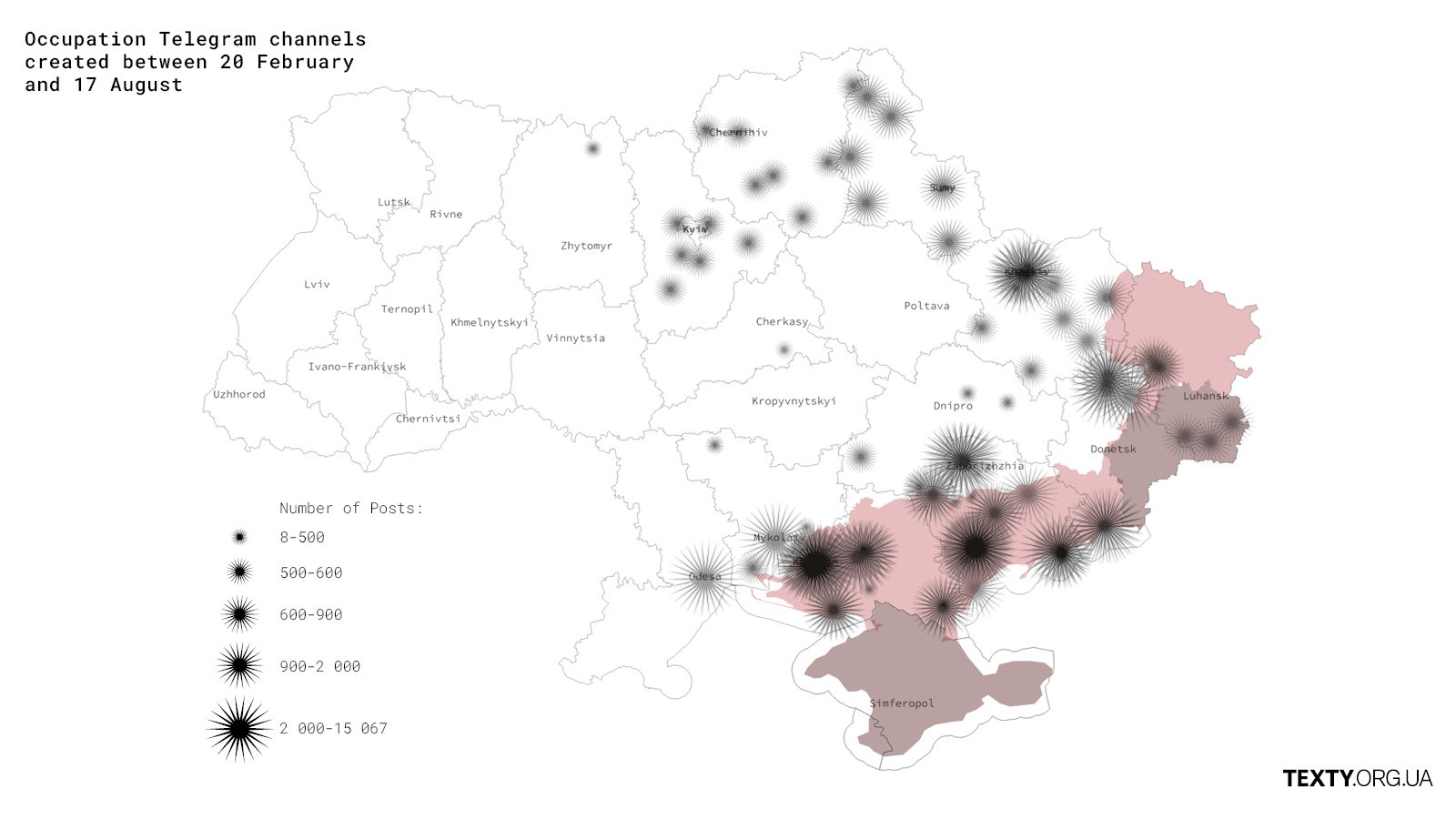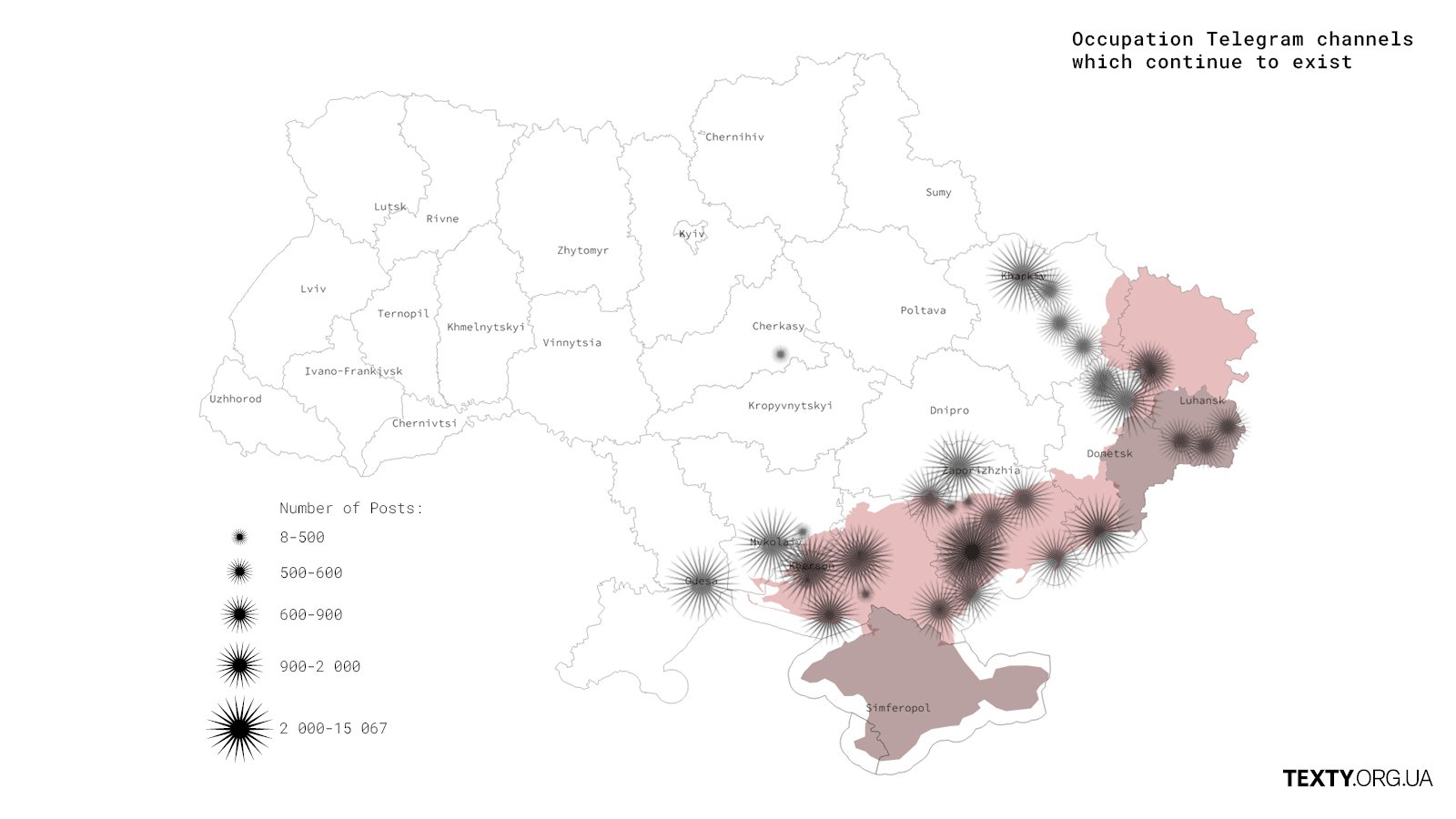Telegram Occupation. How Russia Wanted to Breed a Media Monster, but Ended up with a Paper Tiger.
At the beginning of March, right after the full-scale invasion, Russian information troops targeted regional centers of Ukraine by creating dedicated Telegram channels for each township or community. Although each one posed as a source of local news, those channels were in fact used to disseminate Russian narratives and bolster support for the occupiers. The administrators also used them to imitate such support from the locals.
Читати українською

Telegram Occupation
How Russia Wanted to Breed a Media Monster, but Ended up with a Paper Tiger.
At the beginning of March, right after the full-scale invasion, Russian information troops targeted regional centers of Ukraine by creating dedicated Telegram channels for each township or community. Although each one posed as a source of local news, those channels were in fact used to disseminate Russian narratives and bolster support for the occupiers. The administrators also used them to imitate such support by the locals.
The strategy of creating local sources of propaganda was considered to be quite effective — at least hypothetically. The idea was that local resources would have more chances winning readers’ trust than central channels of Russian propaganda by offering a mix of propagandist narratives and local news which may be of some use for the readers.
The systemic approach to creating Telegram channels in all the occupied villages and towns was confirmed by the captured Russian lieutenant colonel, chief of information countermeasures and operational camouflage division of the 58th Army of Southern Military District of the Russian Armed Forces. He named 10 such channels during the interrogation. However, we managed to identify 120. Sixty-eight channels were created during the first two weeks of war while the others were launched after the occupation forces had gone further and deeper. Later, some of the channels were abandoned and stopped receiving updates.
We mapped those channels to assess Russia’s initial military ambitions.

Interestingly, this image is strikingly similar to the invasion map published by German tabloid Bild before the war.

As the Russian army retreated from Kyiv and slowed down its advance elsewhere, information warfare also stalled considerably: starting from March, new Telegram channels only popped up in the South of Ukraine. From May onwards, new channels were limited to Kherson oblast.
The spread of information aggression is rather uneven: while Kherson and Zaporizhzhia oblasts were riddled with occupation information channels, Kharkiv oblast, which was liberated recently, remained largely “untouched” except Kharkiv itself. This is likely to reflect the priority associated with each occupied territory. Furthermore, such spread of information activity correlates with military efforts. This correlation became evident during the Ukrainian offensive in September: the AFU encountered the least capable troops in Kharkiv oblast as the best-trained units were concentrated in Kherson oblast.
That being said, the beginning of summer marked the shrinking of the network which coincided with a decisive loss of Russian military initiative and deflated ambitions.
Since then, active Telegram channels have only been operational in Kherson and Zaporizhzhia oblasts, and their total count has gradually fallen to 80.
Russian Telegram Empire in Ukraine
Russia has been building a network of (pro-)Russian information propagandist outlets, which pretend to be operated from Ukraine, for many years. Unlike the official mouthpieces of the Kremlin, these outlets are primarily tasked with showing support of Russia and expressing “domestic” criticism of the Ukrainian government. To this end, they maximize the use of various channels: websites, TV, social networks and even printed media.
Eventually, Telegram became one of the most prominent instruments of Russian propaganda, and today this messenger is considered the most popular social network in Ukraine and one of the most dangerous sources of Russian influence. Since content moderation is non-existent on Telegram, Russian propagandists have been operating in uncontested media space. Furthermore, when Internet service is spotty, Telegram updates load faster compared to conventional websites or social media.
In early February 2021, the SSU named 12 Telegram channels with all-Ukrainian coverage which were being maintained by Russian influencers. Those channels target residents of large cities who are interested in politics as well public servants and politicians.
To find out how Russia attempted to manipulate the opinions of Ukrainian members of parliament, read here.
The channels fueled panic and attempted (actually, have been attempting) to destabilize the socio-political situation in Ukraine. Half of them were tailored to stir interest of residents of the largest cities of the east and south of Ukraine It was their launch in late 2018 that marked the start of building regional pro-Russian information-sharing communities on Telegram.
This process culminated after the beginning of the war when Telegram became the number one tool for mimicking local news feeds and showing local support of the occupiers. The SSU identified and even arrested some of the channel operators, but the key persons of interest, who resided outside Ukraine, remained out of reach.
Centralized Russian Content and Fake Subscribers
Considering the identical visual cues and the synchronization of updates to the Russian Telegram channels created after 24 February, which pretended to be Ukrainian, we can safely assume at least half of the 120 channels to have been created as part of a coordinated effort of the Russian information troops. The channels were obviously managed from the same location.
Here is a typical example — a 51-channel network created on 5-7 March. The name of each channel contains the name of the respective city followed by the Russian or Ukrainian flag. Each channel was backed by the same number of fake subscribers that “joined” it during the first days of existence. Each one contained an identical description which invited to contact the administrator with any questions. All the channels published identical texts about Russian humanitarian corridors and humanitarian aid.
The first post in 43 channels was a quotation from the address of Russian military commander, Director of Russian National Defense Coordination Center Mykhaylo Mizintsev. The only difference was the name of the city:

“Residents of [insert city name]!
The humanitarian situation in Ukraine has been getting worse. Today it is on the brink of catastrophe. Russian authorities are doing everything they can to ease the hardships of the Ukrainian people by undertaking humanitarian relief efforts which will continue until the situation is stable”.
Building a Parallel Reality
While waiting excitedly for the Russian army to come, all the aforementioned channels demonstrated their pro-Russian position from the moment of their creation either by adding the Russian flag to the description or actively re-posting news published by large Russian propagandist media such as RIA News or TASS. The text of every third post on the channels in question contained the words “Russia”, “Russian citizen” or “Russian”. None of them even pretended to be neutral. Quite expectedly, such positioning did not make them very popular among Ukrainians.
All their posts fall into two large groups: official Russian propaganda and local news.
By and large, the Russian propaganda in local Telegram channels follows the lines of the official Kremlin rhetoric and focuses on such topics as:
- Russian humanitarian relief efforts to help the Ukrainians and distribution of Russian aid (one of the most popular topics in spring);
- Military success of the Russian army and the dominance of Russian weapons;
- Classic propagandist narratives such as “brotherly peoples”, “common history”, “returning to the fold” and “the mighty Russia”;
- Attempts of weaving these narratives into the argumentation for referendums;
- Demonization of the AFU and aggressive anti-Ukrainian rhetoric.
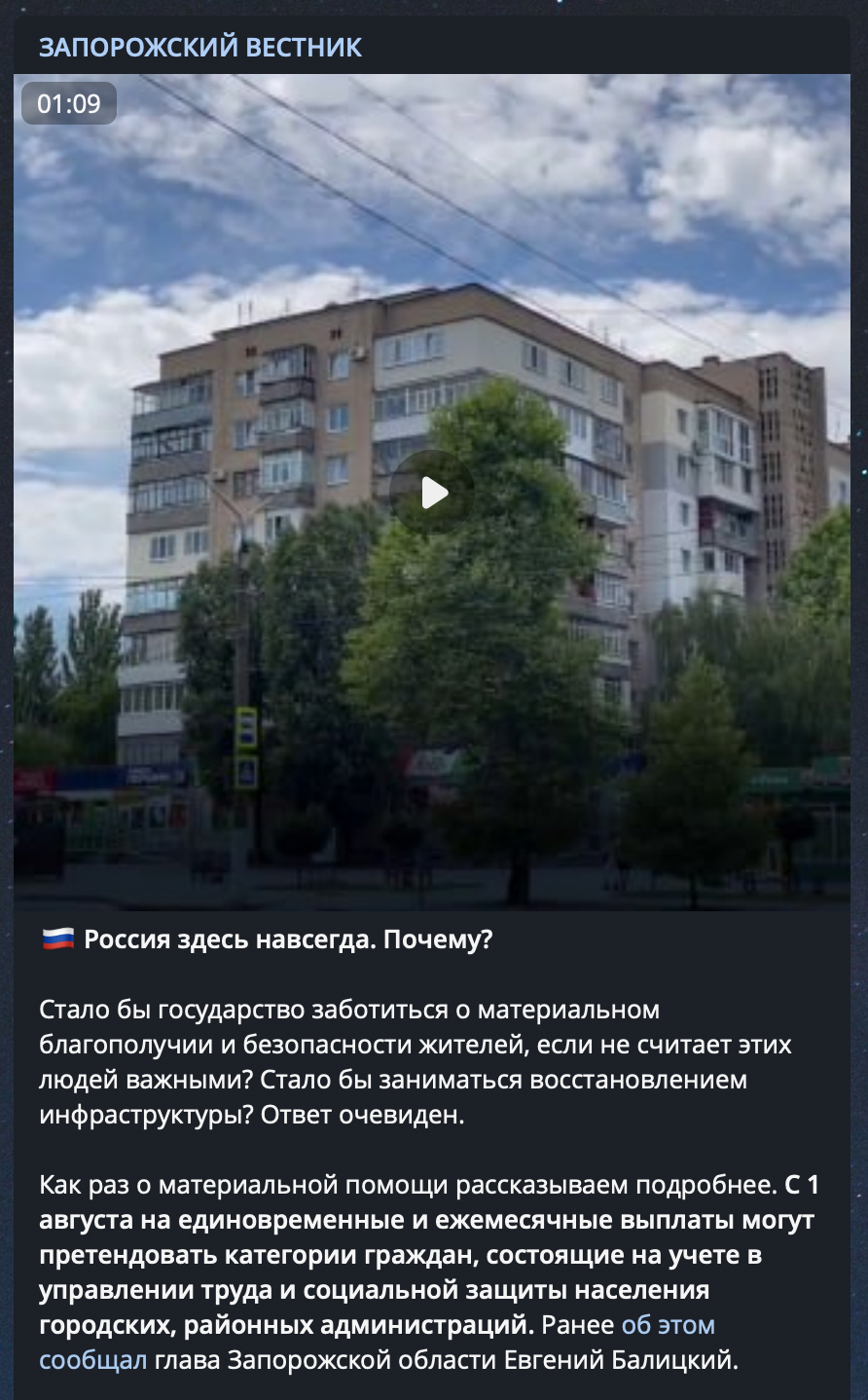
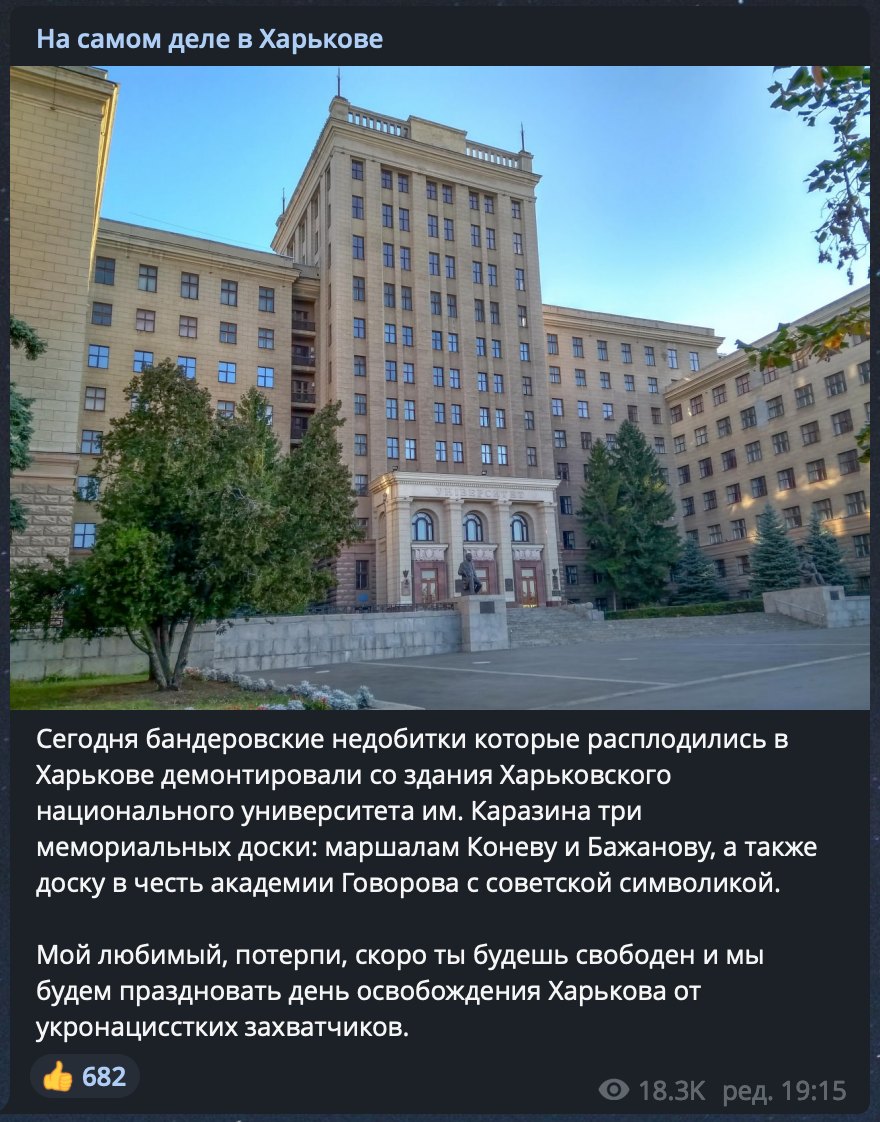

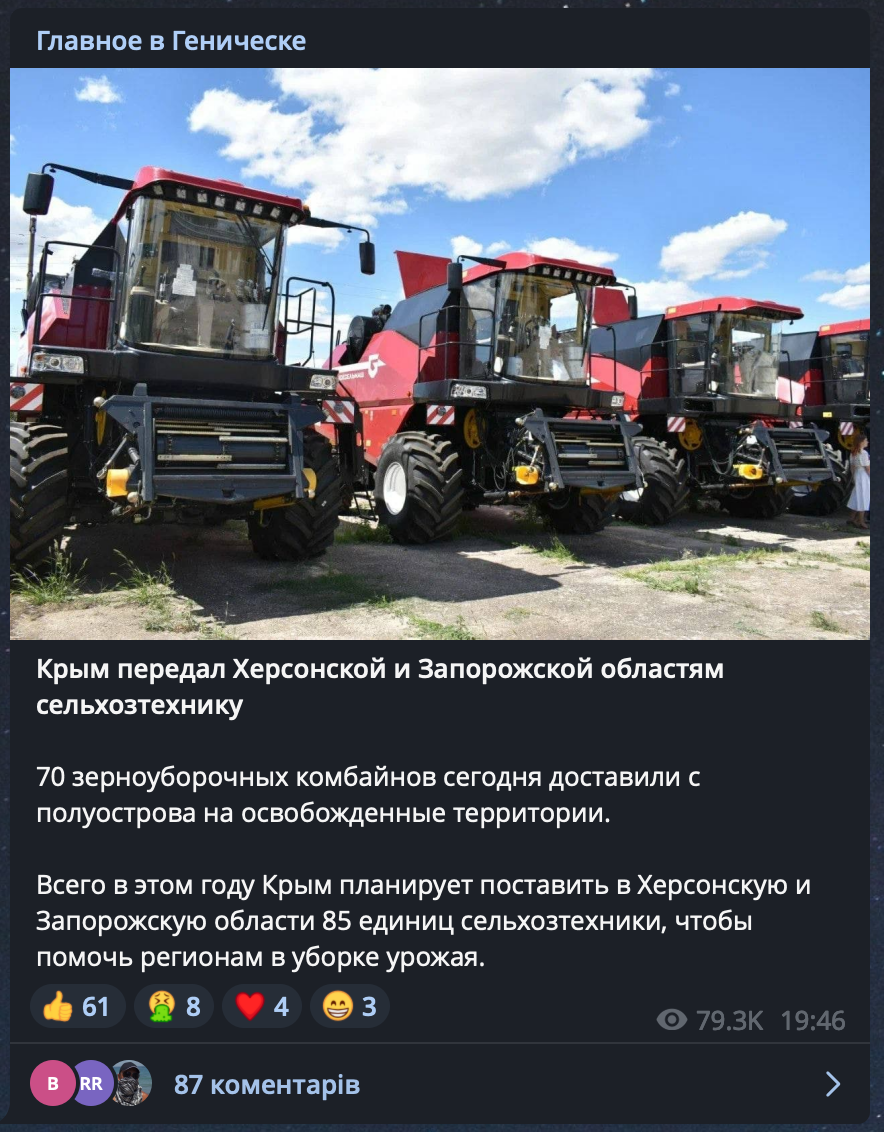
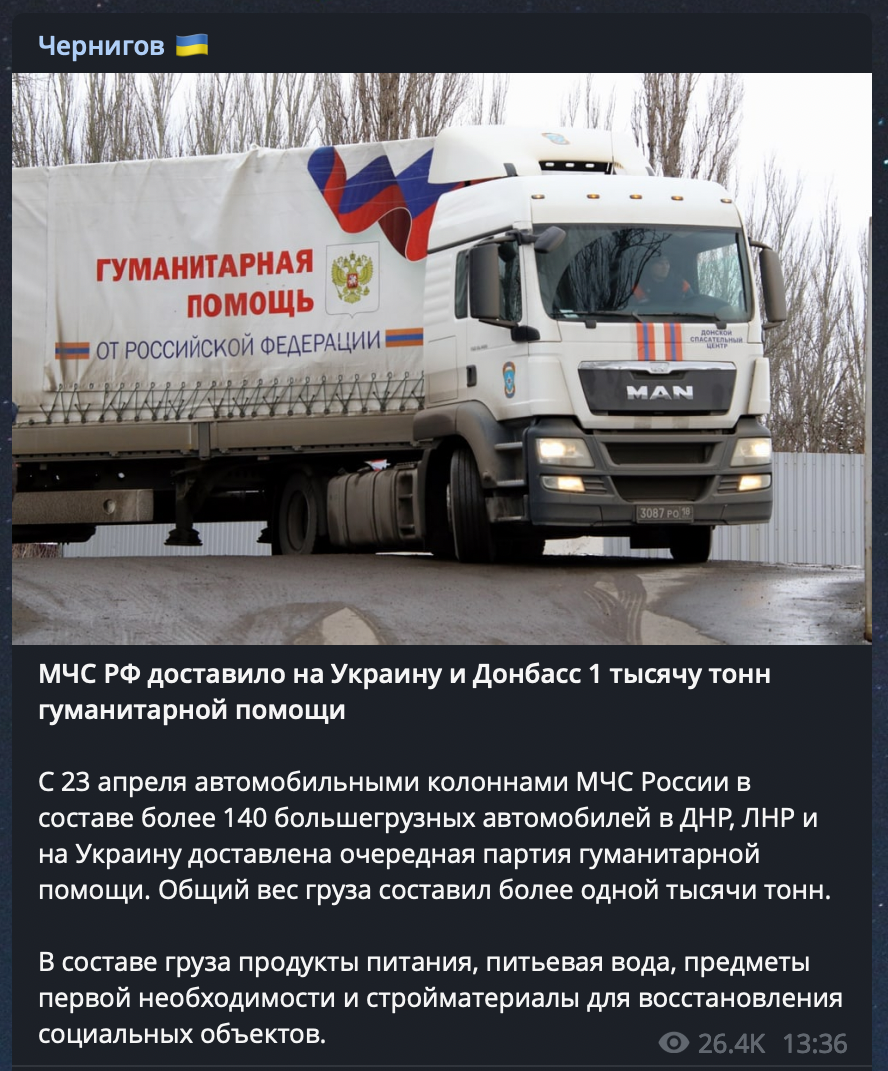
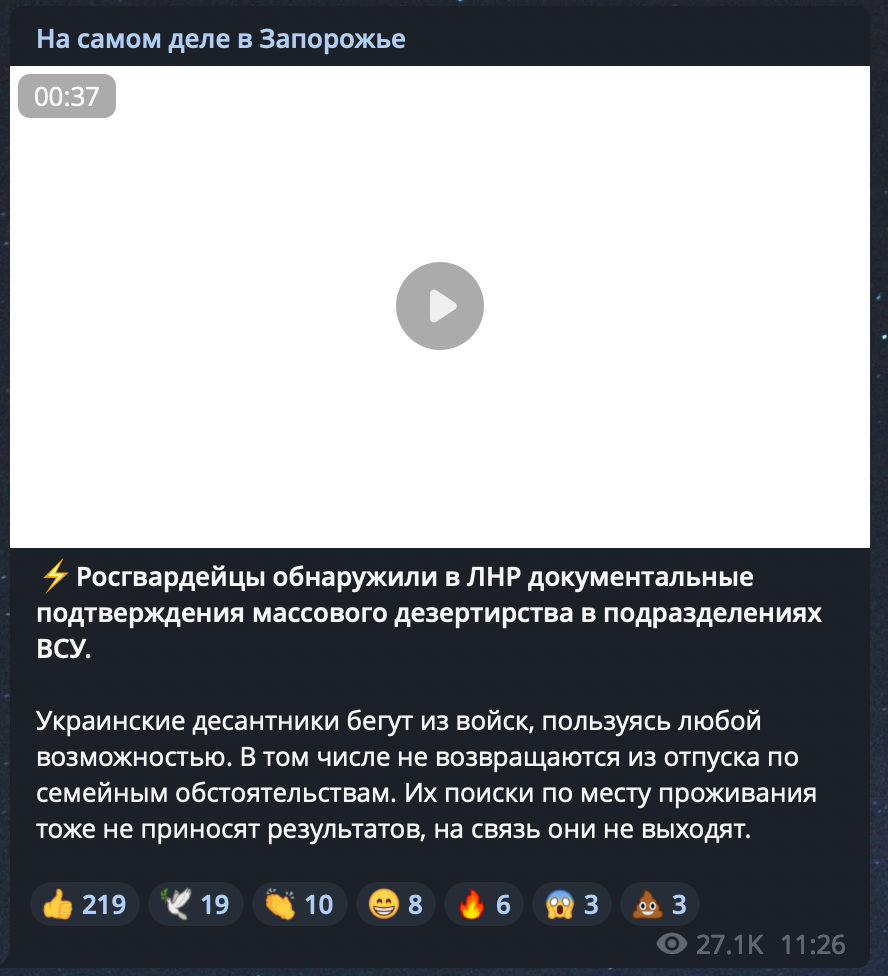

”🇷🇺 Russia is here to stay. Why?
Would the government care about the welfare and safety of the people if it didn't consider them important? Would it be bothered to restore the infrastructure? The answer is obvious. Here is what you should know about the financial assistance. From 1 August onwards all categories of citizens registered with the directorates of labor and social protection of municipal and regional administrations are entitled to one-time and monthly subsistence payments. As earlier announced (https://t.me/BalitskyVGA/100) by the Head of Zaporozhye oblast Evgeniy Balitskiy. For the time being, the amounts are unified. However, they will be tailored to individual needs following the ascension of Zaporozhye oblast into the Russian Federation. Watch the video with all the numbers (in Russian rubles, of course).

“Today some Banderite remnants who still roam free in Kharkov took down three plaques from the facade of Kharkiv State University named after V.N. Karazin: the ones dedicated to Marshal Konev and Marshal Bazhanov and the plaque in honor of the Govorov academy adorned with Soviet symbols. My dear Kharkov, just wait a little longer and you will be free again! The day we celebrate your liberation from Ukrainian Nazi invaders is coming!”

”In this video, we are talking to Kirill, a young boy from Snigirevka in Nikolayev oblast:
"—Is Snigirevka Russian?
— Is it Russian? Are you happy?
— Yeah. I have always wanted to visit Russia".

“Crimea has lent a helping hand to Kherson and Zaporozhye oblasts: 70 harvesters have arrived from the peninsula to the newly liberated territories today. The Crimea authorities have announced plans for sending 85 vehicles to Kherson and Zaporozhye oblasts this year to assist in harvesting the crops in the regions”.

”The Ministry of Emergency Situations of Russia has arranged delivery of 1,000 tons of humanitarian aid to Ukraine and Donbass.
As part of the humanitarian relief efforts which have continued since 23 February, the Ministry of Emergency Situations of Russia used more than 140 trucks to deliver the latest shipment of humanitarian aid to DPR, LPR, and Ukraine. The total weight of the shipment exceeded one thousand tonnes.
The consignment includes food, drinking water, items of first necessity and building materials needed to restore the social facilities”.

“⚡️The members of Russian national guard have come into possession of documentary evidence of mass deserting from the AFU ranks.
Ukrainian paratroopers use every opportunity to skip. When they take a leave of absence to visit their family, they never come back. They stay away from their registered addresses, lose their phones and keep a low profile”.
In fact, the entire official propaganda boils down to two main messages: “Russia is here to stay” and “Russia guarantees a new start for the local residents”.
This network of channels reposts propagandist videos from RT about happy life in Russia with such slogans as “Russia is happiness” and “Russia is care”. They promise to increase subsistence allowances, cut utility payments and add other perks — after the people have voted at the referendum and have been granted a Russian passport or even citizenship. The Crimea is portrayed as a perfect example of happiness and success while turning a blind eye to the host of problems faced by the locals. Unlike the coverage of Crimea, the situation in the occupied Donbass is met with total silence.

Although the local content covers a diverse variety of topics, all the posts fall into two types: announcements which could potentially bring value for the locals and upbeat chronicles with positive mentions of the new occupation authorities to solidify their legitimacy.
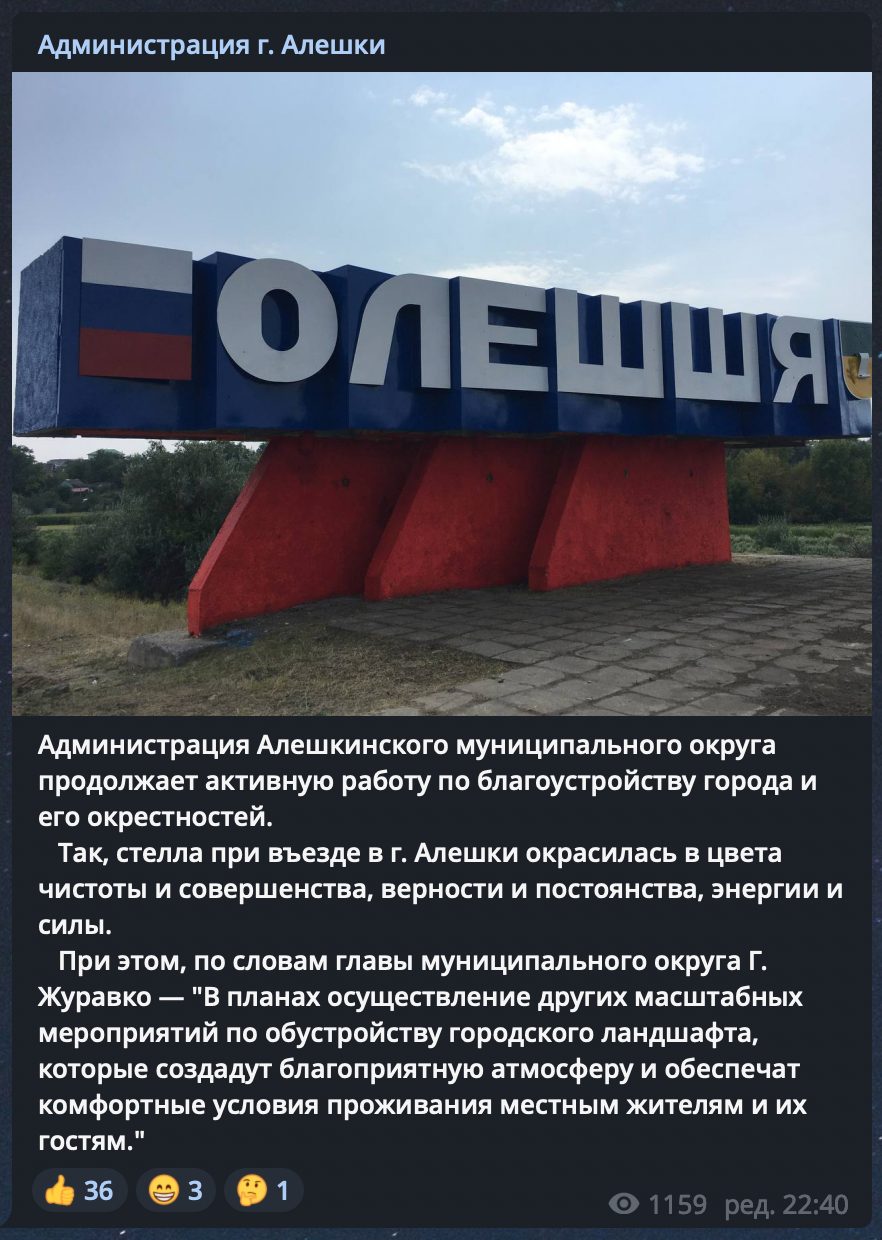
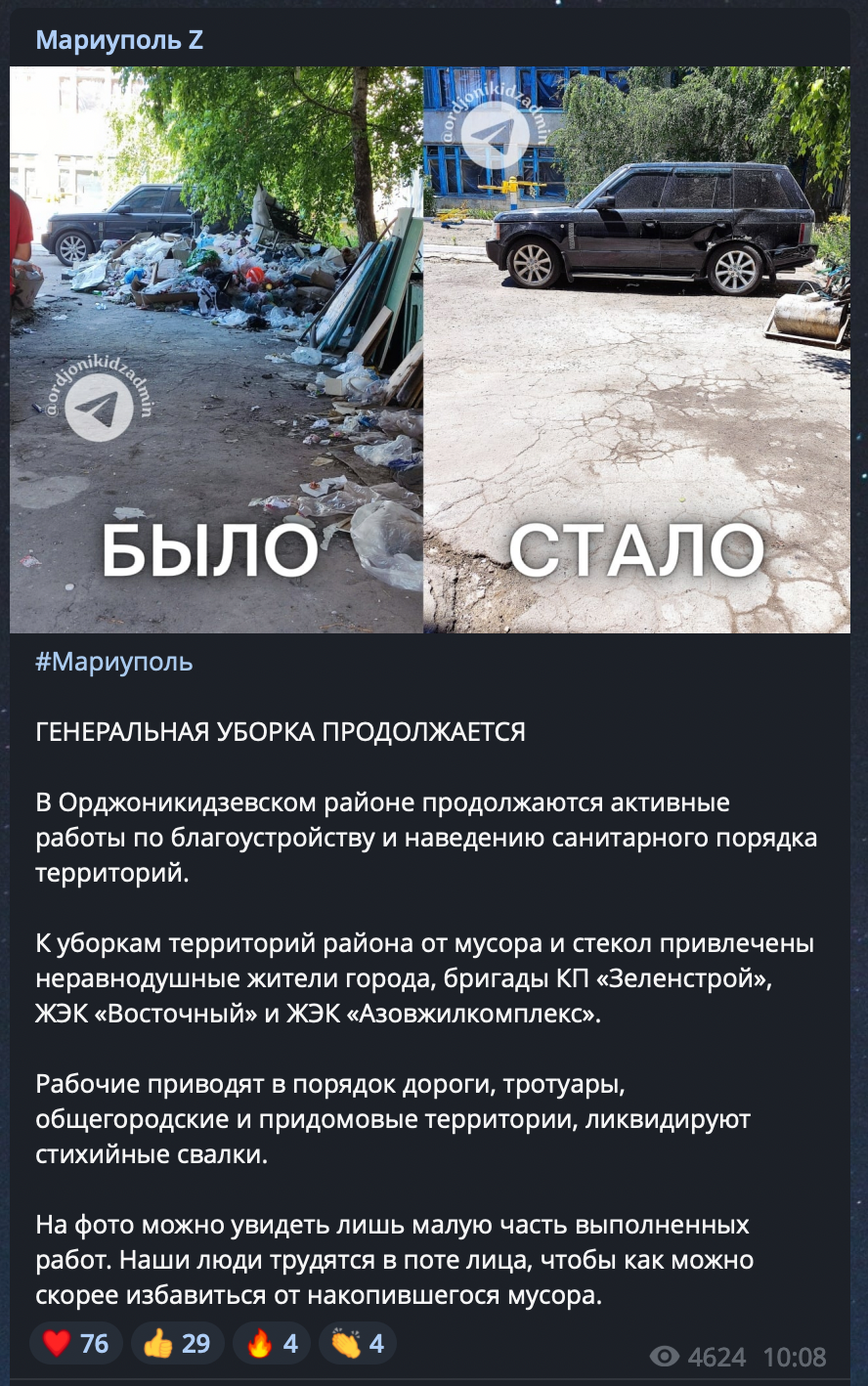
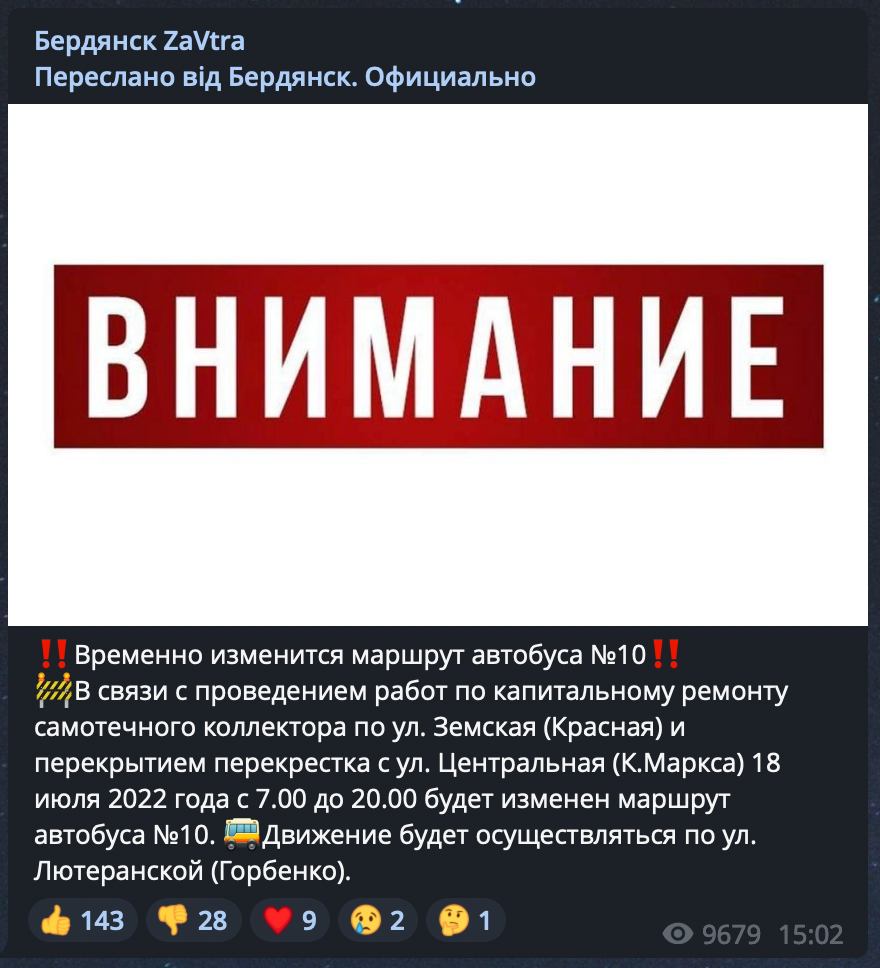
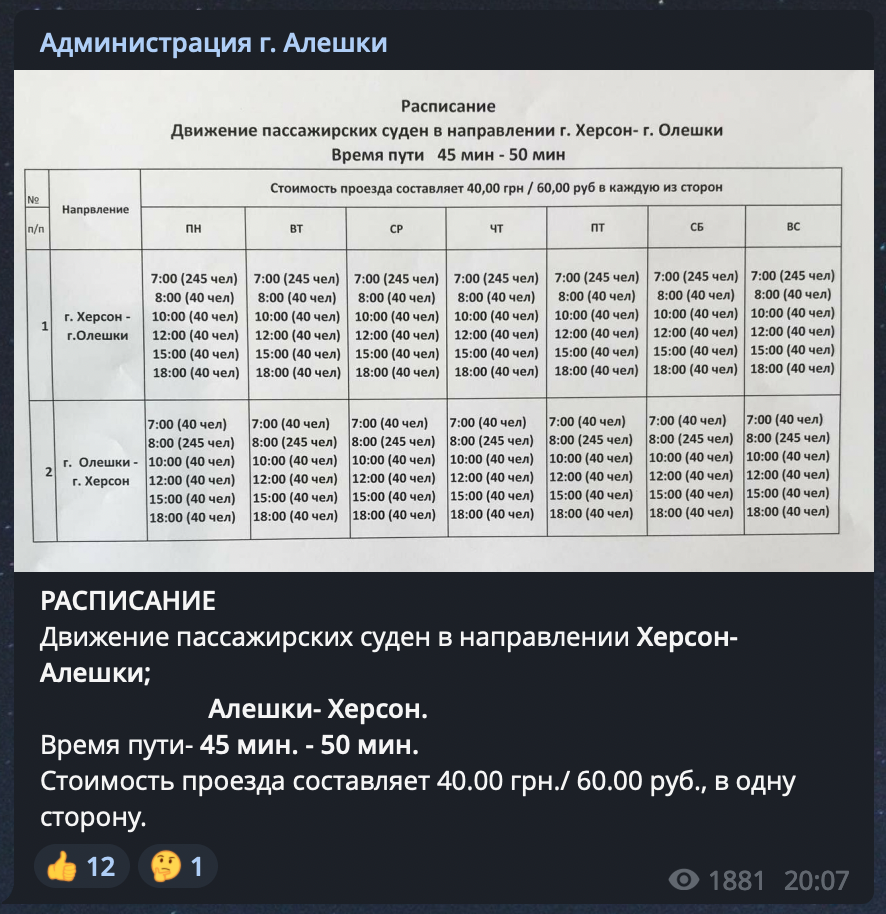

“The administration of Aleshki Municipal District has been busy working on improvements to the infrastructure of the city and its suburbs.
The welcome monument which greets all motorists entering Aleshky has been given a special treatment with the colors associated with purity, perfection, loyalty, perseverance, and power.
According to the Head of Minicipal District G.Zhuravko, those changes are part of large-scale plans for improvements intended to create a comfortable living and working environment for the local residents and guests of the city".

“#Mariupol
GENERAL CLEANING CONTINUES
Wide-scale landscaping and cleaning efforts to restore sanitary order are under way in Orjonikidze district.
The district territories are being cleared from rubble and broken glass by active citizens, KP “Zelenstroy” teams, and “Vostochny” and “Azovzhilkompleks” public utilities offices. Roads, pavements, adjacent territories of buildings and common areas are being put in order and unauthorized dumps are being eliminated. The photo only does as much credit to the amount of work done. Our people are working hard to unclutter the city”.

“‼Temporary changes to the itinerary of bus No.10‼️️
🚧ue to major repairs of the gravity collector sewer in Zemskaya (Krasnaya) Street and the closure of the crossroads with Tsentralnaya (K. Marksa) Street, the itinerary of bus No.10 will be temporarily changed on 18 July 2022 from 7am to 8pm. The itinerary will include Lyuteranskaya (Gorbenko) Street."

“SCHEDULE
Kherson-Aleshky and Aleshky-Kherson ferry services. Duration of journey: 45-50 minutes. Single fare: UAH 40.00 / RUR 60.00”.
The recipe for success of such a Telegram channel is quite simple: maximum focus on local news and minimum amount of propaganda. The more useful local content there is, the more real people subscribe. If upbeat chronicles bear convincing resemblance to journalism, real propaganda becomes more effective raising the chances of the occupation authorities to win the locals’ trust. However, the complexity of managing such a channel grows exponentially.
Model Propagandist
Most channels take the easy path of reposting Russian news and local collaborationists and grow their audiences by adding fake accounts (as is evident from an abrupt single-time spike of the number of subscribers and a considerably lower number of views compared to organic audiences). Still, there were channels which took advantage of speed-dial access to the members of occupation authorities. “The Official Channel of Kahovskaya Military and Civil Administration” is a shining example.
This is one of the first “administrative” channels launched in May. The administrators, whose identities are still unknown, seem to have followed the manual for the entire network quite diligently.
Typical content includes announcements from the administrations of Kahovka children and youth's sports school, schools and kindergartens, news about the availability of Russian number plates for vehicles, happy reviews of school textbooks received from Ryazan, intimidating warnings for entrepreneurs who refuse to put price stickers in rubles, and very few purely propagandist posts such as one entitled “Ukrainian Nazi Swear to Kill Kirill Stremousov”.
Certain Model Information Telegram Channel of the Occupation Forces. The channel has 4,500 subscribers, each post gets 4,000 views on average. These numbers are quite remarkable. Furthermore, this channel is among the best on the network in terms of original content.
Reposts VS Original Content
Reposts are vitally important for most channels. On average, every third post which appears in occupation channels is a repost. However, most content managers try to balance between reposts and their own publications.
85% of the content in Telegram channel “Zaporozhye People’s Republic” is represented by reposts from 370 other channels. More than 1,000 of them were borrowed from channel “War Correspondents of Russian Spring” and almost 800 — from Russian propaganda channel “Rybar”. Since the creation in early March, more than 15,000 messages were posted to the channel over the course of five months.

To make the feed feel local, the managers of Telegram channels created by the occupiers borrowed numerous posts from “related” Telegram channels of the region. Hence, every third repost originated from the network of occupation channels in the region.
For example, the Berdyansk and Melitopol channels (with 8 and 6 channels created for those cities) can be singled out from the network into a separate group based on these criteria. One can't help but notice an artificial network of 51 channels created for different cities of Ukraine which happily reposted one another with little interest in the events outside their bubble.
Ukrainian servicemen acknowledged in private conversations that their adversaries do not report the entire picture of the battlefield to their superiors. According to the intelligence, some junior officers practise staging photo reports for their commanders. This breakdown in communication commonly described by the Russian term “ochkovtiratelstvo” (eyewash) is one of the reasons why the Russian army is performing so poorly. Russian army is also characterized with a rigid management culture which promotes following orders blindly and punishes initiative and improvisation.
It seems that the propagandist army is facing a similar problem.


